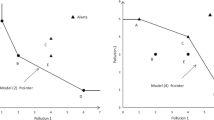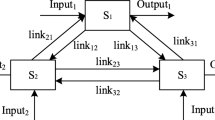Abstract
Data envelopment analysis is a useful model for efficiency evaluation. In order to improve the haze pollution in China, it is particularly essential to allocate the PM2.5 emission rights of various provinces according to the actual situation reasonably. However, the expressions of input and output information are often limited or incomplete. Probabilistic linguistic term sets are employed to increase the expression range of information. Therefore, the proposed probabilistic linguistic term envelopment analysis (PLTEA) model is divided into deviation-oriented probabilistic linguistic term envelopment analysis model and score-oriented probabilistic linguistic term envelopment analysis model. The dual form of the PLTEA model has obtained to solve the actual emission rights distribution problem. Finally, the optimization methods of the distribution efficiency of the PM2.5 emission rights in China in 2019, and some policy suggestions are given to reduce haze pollution.






Similar content being viewed by others
References
Farrell, M.J.: The measurement of productive efficiency. J. Roy. Stat. Soc. 120(3), 253–290 (1957)
Charnes, A., Cooper, W.W., Rhodes, E.: Measuring the efficiency of decision making units. Eur. J. Oper. Res. 2(6), 429–444 (1978)
Mardani, A., Zavadskas, E.K., Streimikiene, D., et al.: A comprehensive review of data envelopment analysis (DEA) approach in energy efficiency. Renew. Sustain. Energy Rev. 70, 1298–1322 (2017)
Zhou, H., Yang, Y., Chen, Y., et al.: Data envelopment analysis application in sustainability: the origins, development and future directions. Eur. J. Oper. Res. 264(1), 1–16 (2017)
Lei, X., Li, L., Zhang, X., et al.: A novel ratio-based parallel DEA approach for evaluating the energy and environmental performance of Chinese transportation sectors. J. Syst. Sci. Syst. Eng. 28(5), 621–635 (2019)
Du, J., Cook, W.D., Liang, L., et al.: Fixed cost and resource allocation based on DEA cross-efficiency. Eur. J. Oper. Res. 235(1), 206–214 (2014)
Wang, Y., Wang, Y.M.: Study on resource allocation DEA model based on the future efficiency with consideration of efficiency & equity: an application in distribution of carbon emission rights in each Chinese province. Chin. J. Manag. Sci. 27(05), 161–173 (2019). (in Chinese)
Lin, T., Ning, J.: Study on allocation efficiency of carbon emission permit in EUETS based on ZSG-DEA model. J. Quantit. Tech. Econ. 03, 37–51 (2011)
Pang, Q., Wang, H., Xu, Z.S.: Probabilistic linguistic term sets in multi-attribute group decision making. Inf. Sci. 369, 128–143 (2016)
Zadeh, L.A.: Fuzzy sets. Inf. Control 8(3), 338–353 (1965)
Hesitant, T.V., Sets, F.: Int. J. Intell. Syst. 25(6), 529–539 (2010)
Atanassov, K.T.: Intuitionistic fuzzy sets. Fuzzy Sets Syst. 20(1), 87–96 (1986)
Zhu, B., Xu, Z.S., Xia, M.M.: Dual Hesitant Fuzzy Sets. J. Appl. Math. 2012, 1–13 (2012)
Zhu, B., Xu, Z.S.: Probability-hesitant fuzzy sets and the representation of preference relations. Technol. Econ. Dev. Econ. 24(3), 1029–1040 (2017)
Zadeh, L.A.: The concept of a linguistic variable and its application to approximate reasoning. Inf. Sci. 8(4), 301–357 (1975)
Herrera, F., Herrera, V.E., Verdegay, J.L.: A model of consensus in group decision making under linguistic assessments. Fuzzy Sets Syst. 78(1), 73–87 (1996)
Herrera, F., Martinez, L.: A 2-tuple fuzzy linguistic representation model for computing with words. IEEE Trans. Fuzzy Syst. 8(6), 746–752 (2000)
Xu, Z.S., Wang, H.: On the syntax and semantics of virtual linguistic terms for information fusion in decision making. Inf. Fusion 34, 43–48 (2017)
Rodríguez, R., Martínez, L., Herrera, F.: Hesitant fuzzy linguistic term sets. IEEE Trans. Fuzzy Syst. 20(1), 109–119 (2012)
Wang, H., Xu, Z.S., Zeng, X.J.: Hesitant fuzzy linguistic term sets for linguistic decision making: current developments, issues and challenges. Information Fusion 43, 1–12 (2018)
Wu, X.H., Tan, L., Guo, J., et al.: A study of allocative efficiency of PM2.5 emission rights based on a zero-sum gains data envelopment model. J. Clean. Prod. 113, 1024–1031 (2016)
Triantis, K., Girod, O.: A mathematical programming approach for measuring technical efficiency in a fuzzy environment. J. Prod. Anal. 10(1), 85–102 (1998)
Zheng M, Zhang Y J, Yan C Q, et al. Review of PM2.5 source apportionment methods in China. Acta Scientiarum Naturalium Universitatis Pekinensis, 2014; 50(6):1141–1154.
Xu, Z.S.: Linguistic decision making: theory and methods. Springer, Berlin (2013)
Zhou, W., Chen, J., Xu, Z.S., et al.: Hesitant fuzzy preference envelopment analysis and alternative improvement. Inf. Sci. 465, 105–117 (2018)
Cooper, W.W., Seiford, L.M., Zhu, J.: Handbook on data envelopment analysis. Springer, Berlin (2011)
Banker, R.D., Cooper, W.W., Seiford, L.M., et al.: Returns to scale in different DEA models. Eur. J. Oper. Res. 154(2), 345–362 (2004)
Huang, Y., Wang, Y.M.: Pareto approach for DEA cross efficiency evaluation based on interval programming. J. Intellig. Fuzzy Syst. 33(4), 2375–2389 (2017)
Frei, F.X., Harler, P.T.: Projections onto efficient frontiers: theoretical and computational extensions to DEA. J. Prod. Anal. 11(3), 275–300 (1999)
Guo, Q.Y., Ding, Z.Y.: Causes and prevention countermeasures for haze: a case study of Xi’an city. J. Anhui Agric. Sci. 43(36), 268–269 (2015). (in Chinese)
Chuai, X.M., Wang, J.J., Zhou, H.X., et al.: A review of causes, influencing factors and countermeasures of haze pollution in China. Meteorol. Environ. Res. 10(3), 25–28 (2019)
Wang, S., Xiu, T.Y., Sun, Y., et al.: The changes of mist and haze days and meteorological element during 1960–2012 in Xi'an. Acta Sci. Circum. 34(1), 19–26 (2014)
Nurhidayah, L.: Legislation, regulations, and policies in Indonesia relevant to addressing land/forest fires and transboundary haze pollution: a critical evaluation. Asia Pacific J. Environ. Law 16(1), 215–239 (2013)
Zhou, Z.X., Xu, G.C., Wang, C., et al.: Modeling undesirable output with a DEA approach based on an exponential transformation: an application to measure the energy efficiency of Chinese industry. J. Clean. Prod. 236, 117717 (2019)
Zhou, Z., Yi, X., Xing, Y.Y.: Analysis on economic development, social stability and smog control equilibrium in Beijing-Tianjin-Hebei region. Stat. Decis. 03, 101–105 (2017). (in Chinese)
Dong, Y.L., Chen, Y., Li, Y.J.: efficiency ranking with common set of weights based on data envelopment analysis and satisfaction degree. Int. J. Inf. Decis. Sci. 6(4), 354 (2014)
Han, Y.M., Geng, Z.Q., Zhu, Q.X., et al.: Energy efficiency analysis method based on fuzzy DEA cross-model for ethylene production systems in chemical industry. Energy 83, 685–695 (2015)
Acknowledgements
The authors would like to acknowledge the financial support of and the National Natural Science Foundation of China (Nos.71971119, 71771155), the Major Program of the National Social Science Fund of China (No.17ZDA092), and the Collaborative Innovation Center of Audit Information Engineering and Technology (No.18CICA01).
Author information
Authors and Affiliations
Corresponding author
Rights and permissions
About this article
Cite this article
Yao, X., Wang, H. & Xu, Z. Probabilistic Linguistic Term Envelopment Analysis Model. Int. J. Fuzzy Syst. 23, 262–279 (2021). https://doi.org/10.1007/s40815-020-00966-y
Received:
Revised:
Accepted:
Published:
Issue Date:
DOI: https://doi.org/10.1007/s40815-020-00966-y




